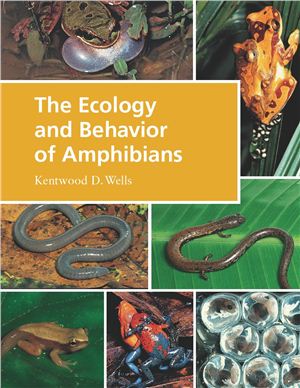The University of Chicago Press, Chicago, - 2007, - 1162 p. В книге
представлены сведения по экологии, поведению, филогении, эволюции
амфибий. Рекомендации по охране исчезающих видов.
Wells Kentwood D. The ecology and behavior of amphibians
- формат pdf
- размер 13.36 МБ
- добавлен 18 ноября 2011 г.

Смотрите также
Cobb A.B. (editor in chief). Animal Sciences. Volume 1
- формат pdf
- размер 7.58 МБ
- добавлен 13 октября 2011 г.
Macmillan Library Reference, 2001. - 242 pages. This encyclopedia set, part of the Macmillan Science Library series, is designed to accommodate middle-school students through college andergraduates. The work contains approximately 300 signed entries on a variety of topics relating to animal science, including animal development, functions, behavior, ecology, and evolution.The connection between animals and humans is also explored in entries suc...
Cobb A.B. (editor in chief). Animal Sciences. Volume 2
- формат pdf
- размер 4.04 МБ
- добавлен 13 октября 2011 г.
Macmillan Library Reference, 2002. - 237 pages. This encyclopedia set, part of the Macmillan Science Library series, is designed to accommodate middle-school students through college undergraduates. The work contains approximately 300 signed entries on a variety of topics relating to animal science, including animal development, functions, behavior, ecology, and evolution.The connection between animals and humans is also explored in entries suc...
Cobb A.B. (editor in chief). Animal Sciences. Volume 3
- формат pdf
- размер 10.09 МБ
- добавлен 13 октября 2011 г.
Macmillan Library Reference, 2002. - 240 pages. This encyclopedia set, part of the Macmillan Science Library series, is designed to accommodate middle-school students through college undergraduates. The work contains approximately 300 signed entries on a variety of topics relating to animal science, including animal development, functions, behavior, ecology, and evolution.The connection between animals and humans is also explored in entries suc...
DeVere Burton L. Fish & Wildlife: Principles of Zoology and Ecology
- формат pdf
- размер 35.74 МБ
- добавлен 12 сентября 2011 г.
Delmar Cengage Learning, 2009. - 416 pages. Fish & Wildlife: Principles of Zoology and Ecology, 3rd Edition, is an introductory applied science textbook intended for use in high school programs focused on agriculture, and natural resource. The text provides a broad-spectrum overview of the wild animals of North America and the environments they live in, including basic principles of science as they apply to wild animals and the habitats they...
Foelix R.F. Biology of Spiders
- формат pdf
- размер 32.11 МБ
- добавлен 21 мая 2011 г.
Oxford University Press, 1996. - 336 pages. An enormous amount of research in spider biology in recent years has resulted in significant new insights into this diverse group of organisms. The response to this outpouring is an updated edition of this widely regarded classic. First published in 1979, this was the first textbook on spiders since 1930; the new edition contains all the information gathered since that time, including the entire world...
Luescher Andrew U. (editor). Manual of Parrot Behavior
- формат pdf
- размер 3.91 МБ
- добавлен 15 сентября 2011 г.
Blackwell Publishing Ltd. First edition, 2006. ISBN-13: 978-0-8138-2749- 0. ISBN-10: 0-8138-2749- 3. (310 pages, illustrated). Subjects : 1. Parrots—Behavior. Parrots are beautiful, they can fly, they are different from us, they are intelligent, and they remain mysterious. This book is written by authors who understand and love parrots in order to help foster a mutually beneficial and enjoyable relationship between parrots and their humans. We h...
Mertz L.A., Allen C.J. Grzimek's Student Animal Life Resource: Amphibians. 3 Volume Set
- формат pdf
- размер 26.09 МБ
- добавлен 16 июня 2011 г.
UXL, 2005. - 584 pages. Grzimek's Student Animal Life Resource: Amphibians offers readers comprehensive and easy-to-use information on Earth's amphibians. Entries are arranged by taxonomy, the science through which living things are classified into related groups. Each entry includes sections on physical characteristics; geographic range; habitat; diet; behavior and reproduction; amphibians and people; and conservation status. Family entries are...
Nowak, Ronald M. Walker's Marsupials of the World
- формат pdf
- размер 43.93 МБ
- добавлен 09 августа 2011 г.
Ronald M. Nowak : introduction by Christopher R. Dickman. - Baltimore : Johns Hopkins University Press, 2005. - vi, 226 p. : ill. ; 26 cm. - ISBN: 0801882222 Authoritative and engaging, this volume from the Walker's Mammals series focuses on marsupials, pouched animals whose unusual method of reproduction—between egg laying and placental birth—places them in a unique category among mammals. A comprehensive guide to the biology and distribution...
Scholtz C. Evolutionary Biology and Conservation of Dung Beetles
- формат pdf
- размер 5.89 МБ
- добавлен 22 ноября 2011 г.
Pensoft Publishers, 2009, 567 pages For a relatively small group of insects, dung beetles have attracted an inordinate amount of scientific interest over the years. This started with the work of the famous French naturalist Jean-Henri Fabre about 100 years ago, but it the work of Gonzalo Halffter of Mexico, and his colleagues, who first placed dung beetles on the scientific map by the publication of two important synthetic works. The first was...
Tasi I., Hornyansky B. Nature's I.Q
- формат pdf
- размер 50.85 МБ
- добавлен 23 мая 2011 г.
Torchlight Publishing, 2009. - 160 pages. It is not at all surprising that insects behave like insects, birds behave like birds, and mammals behave like mammals. They execute most of their intricate behavior in a predetermined, instinctive manner. But how do they know when and how they should act? Where did the intelligence that is manifested in nature come from? Can the current view be true, that inert matter (lacking consciousness) somehow ac...
